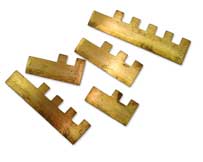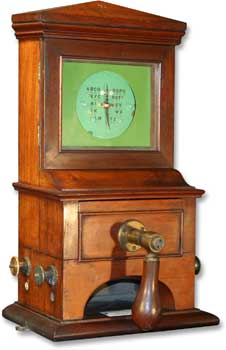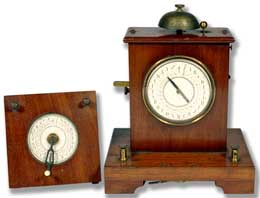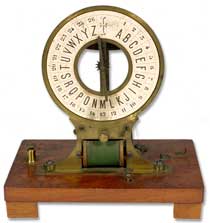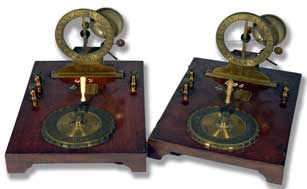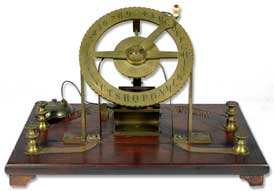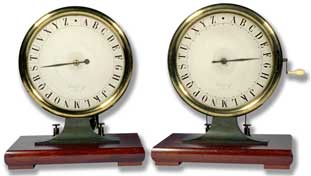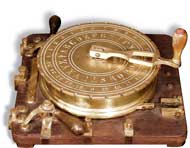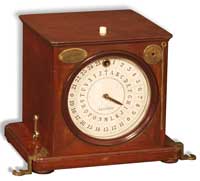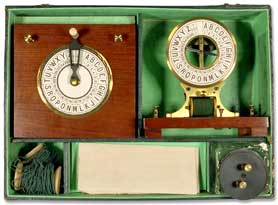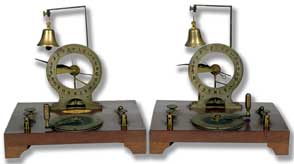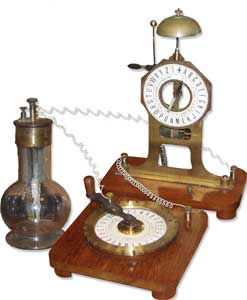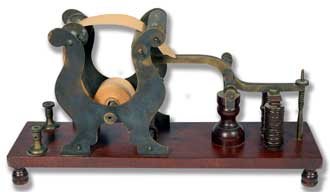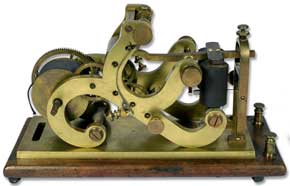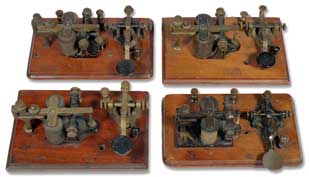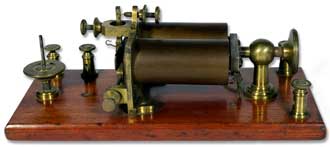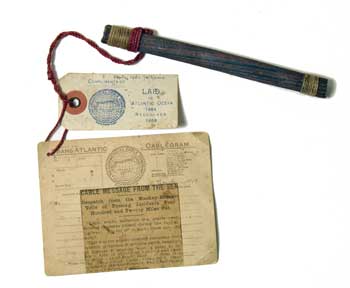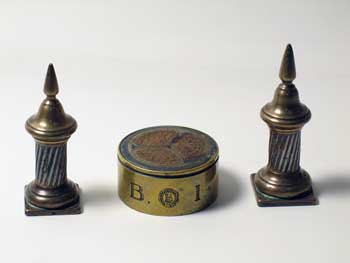| Contact |
| Back | Next | Home |
Early Telegraph Apparatus
This page is still under construction. Background information on wired telegraphy will be added here.
A full size replica of first Samuel F.B. Morse's demonstration model of
1837. This is a copy of the apparatus built from a series of measurements
and photos from the collection of the Science Museum in London. The pen register
receiver is below. The "port rule" transmitter is in the foreground.
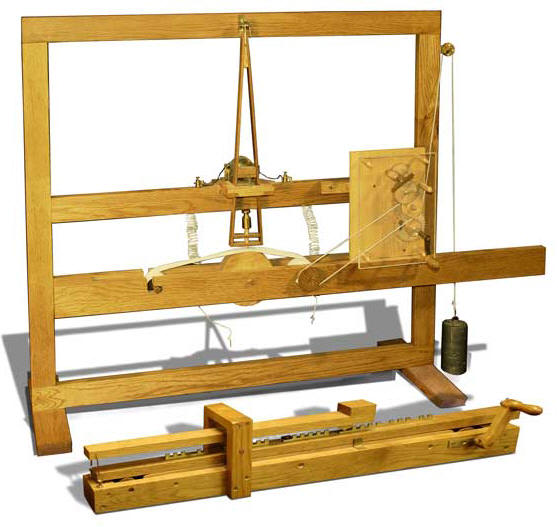
| Morse "Port rule" transmitter. This is the first
transmitter developed by Morse and Vail. It is a good example of
how inventors frequently rely on familiar paradigms. This
apparatus was built on a printing press paradigm, complete with
composting stick and movable type. |
|
|
A few pieces of moveable type from the Port-rule are shown at left. Morse used a code of 1-9, and a codebook was used to convert between sequences of numbers and the words they represented. For example, the sequence "8732" might mean "Reply requested." |
The idea of using a key for transmission didn't occur until later, when, during tests of the Baltimore-Washington line, Vail began sending code by dipping the wires into the mercury cups by hand - a method he found much easier and faster than arranging the type in the port-rule. Shortly after he developed the first crude telegraph key, called the "Finger key:"
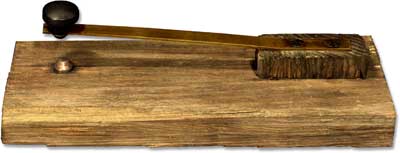
Vail Finger Key
Reproduction of original version
Not long after he developed the finger key, Vail designed an improved version called the "Lever Correspondent." The key was used in the famous 1844 demonstration between Washington D.C. and Baltimore, along with a new system of signals developed by Vail known as the "Morse Alphabet", or Morse code as it is more commonly known today.
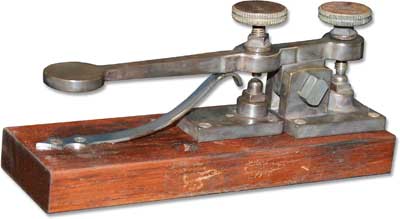
Vail Lever Correspondent
Replica of 1844 version
Below is a "camelback" key from the mid 19th
century. Named for their characteristic "hump", camelback keys were
among the first telegraph keys placed into commercial use.
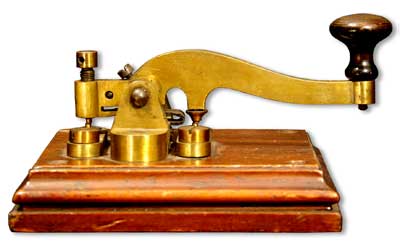
European Camelback Key
Mid 19th Century
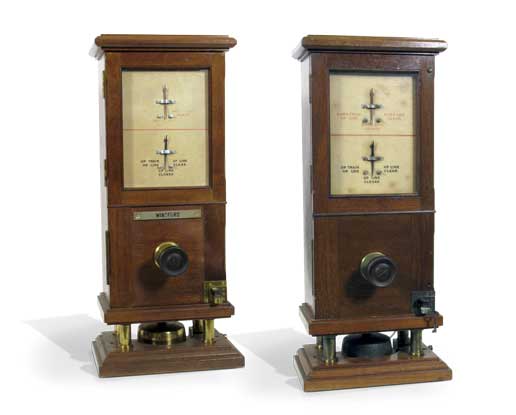
Pair of Two-Needle Railway Block Telegraphs
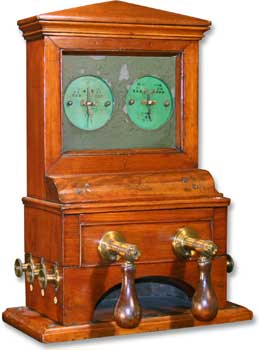 Cooke-Wheatstone Double-Needle Telegraph ca. 1840's |
|
|
Click here to see this key before restoration |
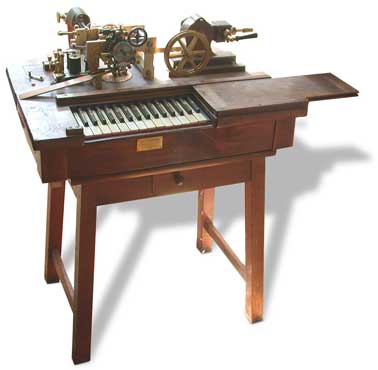 Hughes Telegraph Dumoulin - Froment a Paris Mid 19th Century Operated on the Paris - Milan line
|
The Hughes
Telegraph What makes the Hughes unique? On the sending side, instead of using a Morse key, the operator uses a piano key – or keyboard, to be more precise. The receiver, instead of marking dots and dashes on a paper strip, actually spells out the text of the message. This was quite unusual for the time. These devices were very popular in France, where there were likely many more piano and harpsichord players than telegraphers. The piece we have in the museum was operated on the Paris-Milan line. Unfortunately they were quite temperamental and suffered frequent breakdowns. Transmission speed was also much slower than the Morse system and so the Hughes system was eventually replaced by the much simpler (and cheaper) Morse apparatus. Very few survive today.
|
Alphabet Dial Telegraphs
|
Breguet-Style Dial Telegraph |
Demonstration Dial Telegraph Receiver |
Dial Telegraph |
|
|
|
Ruhmkorf Alphabet Dial Telegraph The telegraph is an early example of the Wheatstone apparatus and is made from silver, brass, mahogany and iron. See pg. 100 figs. 13a and 13b in Pioneers of Electrical Communication. |
|
|
|

Breguet Dial (ABC) Telegraph |
|
Dial Telegraph Kit In green covered paperboard box, with instructions, 2 spools of silk-covered green wire and battery. Box measures 12" x 9"x 3-3/4". Sending and receiving dial telegraph apparatus used to demonstrate Wheatstone's alphabet dial telegraph invention. |
|
|
Early Telegraph Registers
 Very Early S.F.B. Morse Design Weight Driven Telegraph Register J.W. Norton 1851 Norton was the first telegraph manufacturer in New York City and worked at this address in 1851. He was also on the first board of directors of the Magnetic Telegraph company in 1846. In Samuel F.B. Morse, His Life and Letters (edited by Morse's son Edward Lind Morse), the frontispiece photograph in Vol. 2 is of S.F.B. Morse holding this exact Norton register in his hand. Original hand made chain is also present on this register. |
John Dean Caton was an associate justice of the Supreme Court in Illinois and later became resident of the Illinois and Mississippi telegraph line and a telegraph manufacturer. This is a very early example from the Caton shop from the early 1850's. |
|
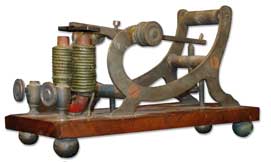 Demonstration Telegraph Register Daniel Davis 1840's
This
apparatus was part of the collection of J.M. Wightman objects found
together. It was likely sold by Wightman whose 1842 catalog is bound
with 1842 edition of the Davis Manual of Magnetism. |
|
|
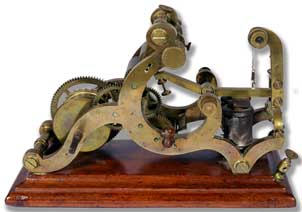 Early S.F.B. Morse Design Weight Driven Telegraph Register James Clark 1860 James Clark was a maker of early electromagnetic telegraph instruments and was in business from 1847 - 1861. It is very rare to find instruments by this maker. |
.
Early S.F.B. Morse Design
|
|
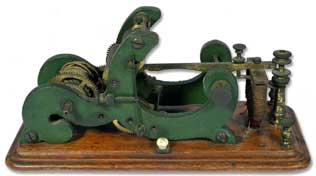 Early S.F.B. Morse Design Weight Driven Telegraph Register unsigned 1850 Provenance: from the Charles Came collection of philosophical and telegraph instruments - see Rittenhouse Vol. 5, No. 4 1991 pgs. 118-128. The U-shaped electromagnet and binding posts, as well as the provenance suggests manufacture date circa 1850. |

Early S.F.B. Morse Design The number "1" is stamped in numerous places on the brass-work. See Prescott pg. 75. Tillotson was manufacturing telegraph apparatus for a brief period only at this address in the 1860's. |
|
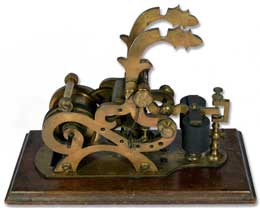
Early S.F.B. Morse Design Fancier and more elaborate design American telegraph register by very famous maker. Elaborately turned and cut brass, with large gutta-purcha electromagnetic coils. |
This is a demonstration apparatus meant to show how electromagnetism can be applied to transmit intelligence over a distance. Chamberlain was a philosophical instrument maker in Boston and displayed/sold Davis apparatus in the 1840's. |
|
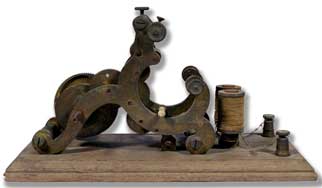 Very Early S.F.B. Morse Design Weight Driven Telegraph Register Unsigned 1850 |
Telegraph Keys and Sounders
|
Found in Cambridge, Massachusetts; from left to right: (1) unusual telegraph sounder on walnut base measuring 5-3/4" x 2-3/4"; (2) electrical bell connect to microphone on walnut base measuring 6-2/4" x 3-1/4" and (3) unusual telegraph key on tin box base measuring 5-3/4" x 3". The design of the binding posts, hand cut nuts and electrical coils all suggest that these instruments are circa 1850. |
Telegraph Practice Boards
|
|
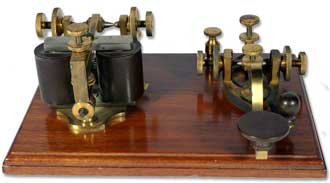
Camelback Key and Sounder on Board
|
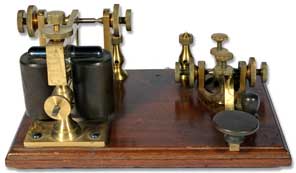
Camelback Key and Sounder on Board
|
|
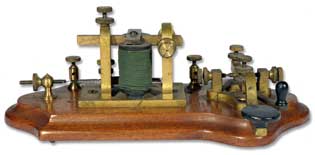
Camelback Key and Sounder on Board
|
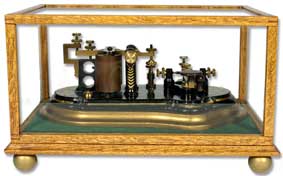 Telegraph Key and Sounder on Cast-Iron Base L.G. Tillotson and Co. New York 1870
|
|
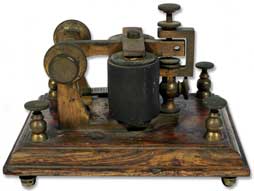
Telegraph Sounder
|
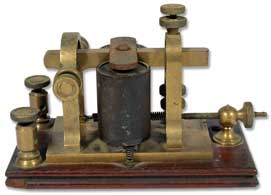
Telegraph Sounder
|
|
 Demonstration Telegraph Key T. Hall, Boston 1860
|
||
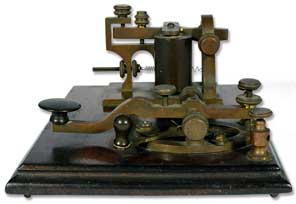
Telegraph Key and Sounder on Board
|
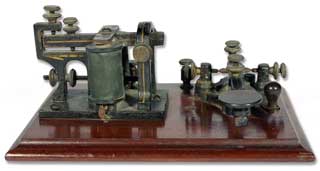
Telegraph Key and Sounder on Board
|
|
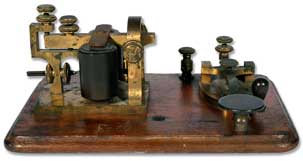
Victor Telegraph Key and Sounder on Board
|
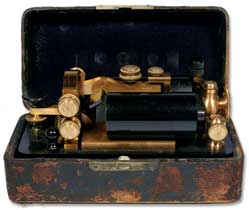
Portable Lineman's Telegraph Set in Box
|
|

Telegraph Alarm Bell
|
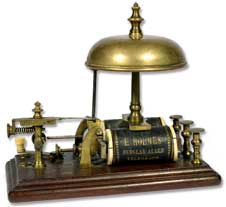
Holmes Burglar Alarm Telegraph
|
Telegraph Relays

Very Early Telegraph Relay Same manufacturer and provenance as the Caton register described above. |
Very Early Telegraph Relay Same manufacturer as Morse register, above.. Charles T. Chester made telegraph apparatus in New York City in the 1850's after taking over J.W. Norton's shop. |

Early Telegraph Relay |
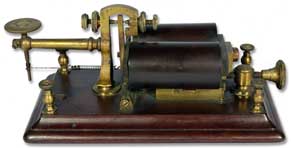
Early Telegraph Relay |
 Telegraph Relay likely by Charles Williams, Jr. 1870 |
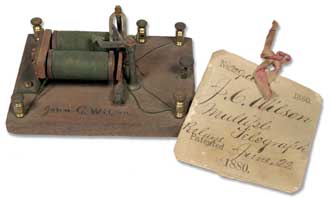
Multiple Telegraph Relays J.G. Wilson No. 229, 068" signed as above on U.S. Patent office tags and signed on wood base. Walnut base measures 4-1/2" x 3-1/2". See The Art of Invention Part II, Christies 1996, pg. 18. |
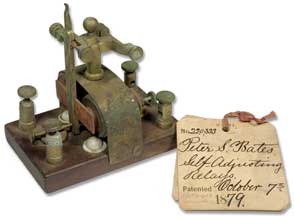
Self-Adjusting Relays Peter S. Bates, No. 220, 333" signed as above on U.S. Patent Office tags. Walnut base measures 4-1/4" x 2-3/4". See The Art of Invention Part II, Christies 1996. pg. 23.
|
|
Other Telegraphy Apparatus
|
|
|
||
|
|
|
|
||
|
|
|
|
||
|
||||
| Contact |
| Back | Next | Home |
